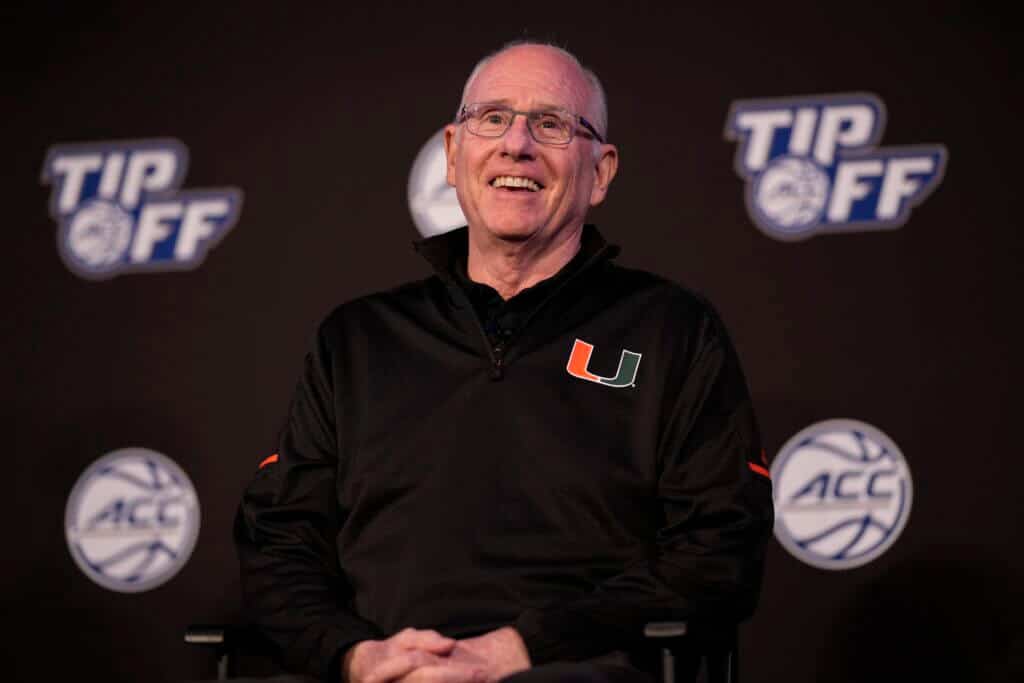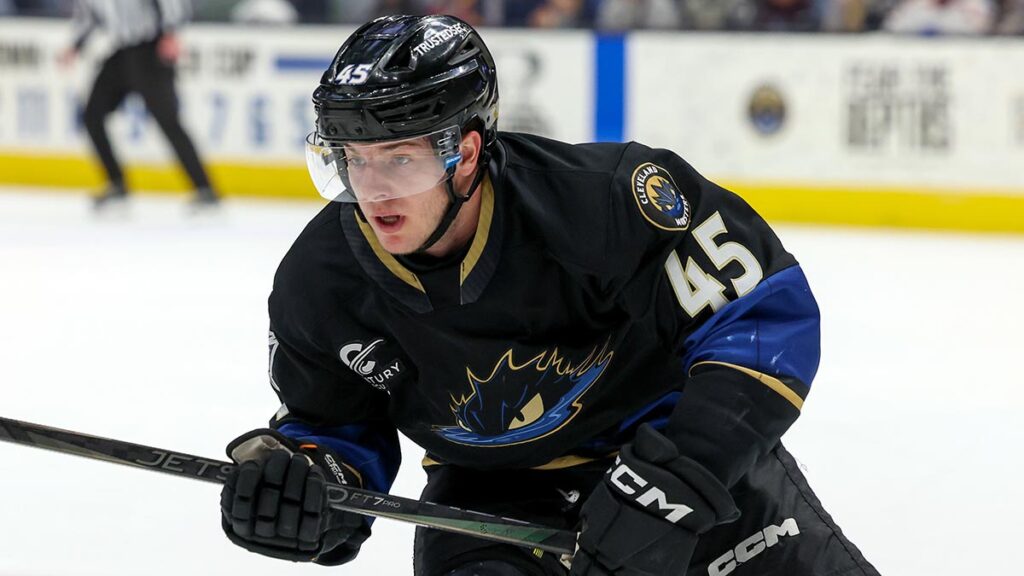CHARLOTTE, N.C. — Care for a splash of cold water on your annual hopefest?
No?
Too bad. It’s knife-twisting time.
Normally at events like this week’s ACC Tipoff, optimism is the only thing outpacing team athleisure, and just barely. This go-around, though? Sure, there was still some — North Carolina and Duke once again have championship aspirations, and the bottom-most bar for everyone else is an NCAA Tournament berth — but give the conference’s coaches some credit: They’ve learned how to hold a grudge.
Specifically, with the rest of the men’s college basketball universe. Last season, the ACC — the college basketball conference, or at least how it likes to publicly position itself — sent its fewest amount of teams to March Madness since 2013. It was only four back then, nine years ago, and if not for Virginia Tech’s last-ditch dash through the ACC tournament, probably would’ve been once again in 2022. Instead, the league got a fifth school in … only for the Hokies to flame out in the first round. Yippee! What, no applause?
But the issue wasn’t just real or perceived postseason slights; it was the season-long side-eye the ACC saw from a national perspective, the wider narrative that the conference had a “down” season. By mid-January, facetiously or not, #OneBidACC temporarily trended across social media.
And yet, two months later, the same league made up half the Final Four.
“You don’t do that,” Miami coach Jim Larrañaga said, “when your league is down.”
So, which is it? Down, or just dormant? A problem with play, or just perception?
Realistically, some of both. Four ACC teams began last season ranked in the AP poll — Duke (at No. 9), North Carolina (No. 19), Florida State (No. 20), and Virginia (No. 25) — so it wasn’t like the league started out on a low. But notable early-season struggles quickly snuffed out any sterling offseason shine, at least for the latter three. “Listen, it is what it is. We live in a world that, out of the gate, nonconference really matters,” commissioner Jim Phillips said. “We didn’t perform at as high of a level as we needed to.”
Just how bad was the ACC’s nonconference start? If you look at the nine ACC teams who finished last season with a winning record, they collectively played 36 nonconference games against teams that ended the year in KenPom’s top 100. Those are the sort of needle-moving wins the league needed … and, by and large, didn’t get. The ACC won just 14 of those 36 games — 38.8 percent. Even worse: Only three of those 14 came against top-25 KenPom clubs, two of which were wins over Kentucky by Duke and Notre Dame.
They all came back for one reason ?@UNC_Basketball pic.twitter.com/Q8v2tvJ3PJ
— ACC Network (@accnetwork) October 12, 2022
And it wasn’t just that the league lost marquee matchups; it also fumbled against inferior foes. Virginia lost to both Navy (No. 184 in KenPom’s year-end rankings) and James Madison (No. 227), while Florida State needed overtime just to get past Boston University. By mid-December, the league’s expected torch-bearers were just trying to keep their heads above water. “A lot of us didn’t do well out of conference, so we didn’t get to build those rankings up,” Virginia Tech guard Hunter Cattoor said. “Then once you get to ACC play, Duke’s the only one ranked.”
By that point, it was a self-fulfilling prophecy: Lose to Duke, and there goes your one shot to beat a ranked opponent. Beat Duke, and — wait, who else have you beaten?
In the moment, it was easy to dump on a conference that doesn’t usually stub its toe so severely. But in hindsight, as Larrañaga said Wednesday, there was more to it than that.
For example, the Hurricanes played in the ESPN Events Invitational last November, with three games in the span of four days. By the time the third game rolled around, against Alabama, Miami’s players were exhausted, especially so early in the year and with lingering COVID-19 protocols that cut back on their conditioning. Larrañaga decided to “experiment” and play zone that game, still unsure which tactics would maximize his collection of talents. “They beat us by 32,” Larrañaga said. “What does that do to your coach? It makes him look like an idiot.” On the surface, sure. But it also told Larrañaga that, yeah, zone probably wasn’t the best fit for his small-ball team, which gave up 3-pointers aplenty to the Crimson Tide. He nixed the defensive scheme, and doubled down on his original pressure-based scheme. Boom: Miami immediately followed that blowout loss with nine straight wins.
And yet, in the court of public opinion, the Hurricanes were horrible. It wasn’t until they beat Duke, the ninth and final win in that stretch, that Larrañaga’s team won back some public favor — and by that point, it was mid-January. Six weeks, just to undo one sordid game.
“I felt like we were playing good competition every game, and we got the best from every team,” Miami guard Isaiah Wong said this week, “but when we beat Duke, that’s when all the social media started going crazy.”
Same deal for UNC, which lost two rotation players midseason and completely changed its defensive tactics. And there are other examples of how vital info-gathering games early on in the season weren’t representative of a team’s final product. Didn’t matter. Stink before Christmas, and you’re cursed with a steep uphill climb.
This makes what the ACC accomplished in the postseason — by virtue of Miami reaching the Elite Eight, UNC and Duke meeting in the Final Four and the Tar Heels coming within one big man’s bum ankle of winning the whole dang thing — that much more astounding, or depending on who you ask, confounding.”.
This means that while, yes, there were plenty of salted wounds this week, there also was an undercurrent of comeuppance.
The ACC — which has finished fifth in KenPom’s conference rankings the past two years after placing fourth in 2019-2020 — is back, baby. Right? (Or did it never leave?)
There are reasons for optimism, though, even for the overly cautious. Armando Bacot is back, the ACC’s lone first-team all-league returner from a season ago, as are three other members of UNC’s idolized “Iron Five.” The Tar Heels very well may start the season as the No. 1 team in the country.
Three other All-ACC honorees — Wong, Virginia’s Jayden Gardner, and Notre Dame’s Dane Goodwin — return as well, along with six honorable mentions and Matthew Cleveland, the reigning ACC Sixth Man of the Year. On top of that, the league welcomed two of The Athletic’s top five overall offseason transfers — Pete Nance at North Carolina, and Nijel Pack at Miami — and a number of other expected starters, like Norchad Omier at Miami and Jacob Grandison at Duke. And while the league did lose plenty of talent, largely to the NBA Draft, Duke once again welcomes in the nation’s No. 1 recruiting class, among them plenty of projected lottery talents and expected award winners.
That’s good news for a league that, even months after the season’s end, is still trying to explain away last year’s slump.
“In this day and age where rosters change so dramatically that it is just kind of a new slate when we tip off on November 7th,” Phillips said, “everybody will be wondering.”
Wondering, sure, but also waiting. The ACC is a proud entity, and the best way to get back to its nationwide basketball mantle?
Win. Early, and often.
(Photo of Miami coach Jim Larrañaga: Jim Dedmon / USA Today)






